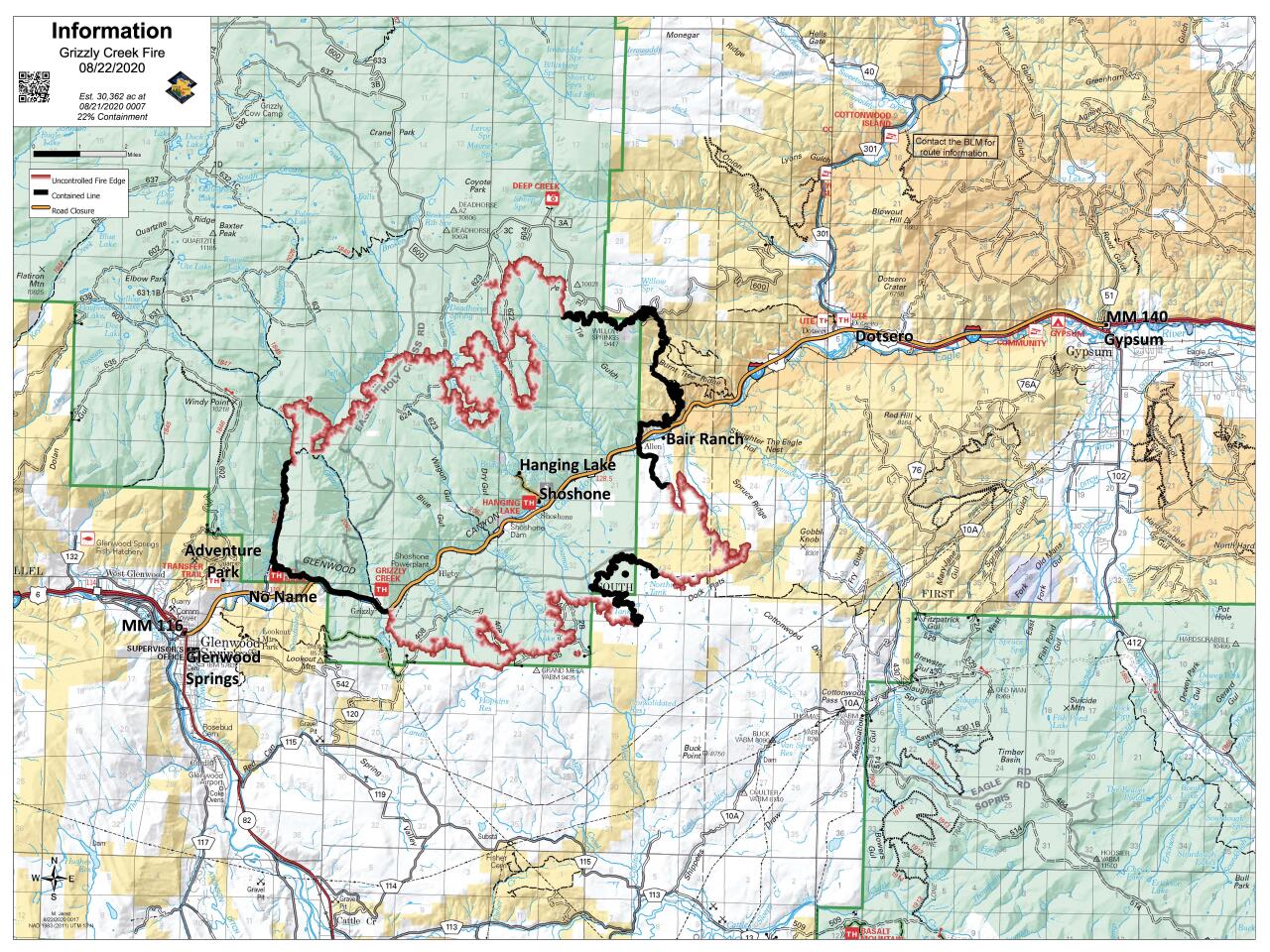GLENWOOD SPRINGS, Colo. – Firefighters were able to bring the Grizzly Creek Fire to 30% containment as of Sunday morning, with 30,362 acres having already burned – an uptick in about 400 acres burned but a jump of 8% in containment.
Fire crews now have established containment lines on the northwest side of the fire from the No Name drainage to the I-70 corridor, along Coffee Pot Road to I-70 on the fire’s eastern side and a small containment line on the south side of the fire.

Crews built a line around Bair Ranch and burned out areas up to Ike Ridge. There was little growth in the No Name and Grizzly Creek drainages on Friday. Helicopters continued to blanket the western side of the fire with retardant dropped by helicopters.
Fire management said crews expect moderate or active fire behavior Saturday, with hot and dry conditions and light winds forecast. Burnouts will continue on the east side of the fire between the active fire and the containment lines in order to further secure containment lines.
On the west side, crews will be in the Bear Creek and Lookout Mountain Park areas.
Gov. Jared Polis on Friday authorized the Colorado National Guard to help with search and rescue missions. At the request of the State Emergency Operations Center, a Colorado Army National Guard UH-60 Black Hawk crew is on standby at the training site in Gypsum – just east of the Grizzly Creek Fire – for search and rescue capabilities and evacuating firefighters and residents.
There is a Facebook Live community meeting planned for 6 p.m. on the fire’s Facebook page. The cause of the fire, which started on Aug. 10, remains under investigation.
Eagle County said Saturday that Cottonwood Pass Road will be opening back up Sunday for local passenger vehicle traffic for critical needs – like travel to and from work or school, a doctor’s appointment, or other essential businesses in Eagle, Garfield and Pitkin counties. Only passenger vehicles and pickup trucks will be allowed, and drivers should be prepared to show ID and proof of a need to travel.
Construction and delivery truck travel will be allowed on certain hours on Mondays, Wednesdays and Fridays by reservation only. Reservation forms can be filled out here. The road had been closed after vehicles not suited for the road and drivers not knowledgeable with the area got stuck trying to get around the I-70 closure.
Forest Service Road 400 is also closed after drivers mistook it as an optional other route and got stuck or crashed. Coffee Pot Road, Transfer Trail and Clinetop Mesa also remain closed.
Officials said earlier this week they expect it to be days, not weeks, before I-70 reopens, but did not give a specific timetable. The Grizzly Creek Fire shut down I-70 from Glenwood Springs to Gypsum Aug. 10, and the interstate has remained closed since then in that area.
The workaround for most drivers is U.S. 50 east to U.S. 285 for those coming east from Grand Junction, and CO 9 to U.S. 285 south to U.S. 50 for westbound drivers, or CO 91 to U.S. 24 to U.S. 50 westbound. Click here for the Denver7 traffic map.
A White River National Forest fire official drove Glenwood Canyon on Friday and posted video to the fire’s Facebook page as officials continue to assess damage to the forest and the areas in and surrounding the canyon.
Air quality for smoke is moderate in the area on Saturday.
There were 873 total personnel on the fire as of Saturday morning, including 18 hand crews, 11 helicopters and 44 engines.
The Bureau of Land Management has closed recreational sites and boat ramps on the southern side of the Colorado River near Dotsero, including the Cottonwood Landing ramp, Lyons campground and ramp, and the Dotsero ramp.
Crews are expecting active fire weather through the weekend, with the possibility of some moisture early in the week. Crews continue to coordinate with CDOT and Xcel Energy to repair power poles and lines and identify rock and debris stability on the sides of Glenwood Canyon.
The Grizzly Creek Fire is one of four major fires currently burning in Colorado. Click here for more Denver7 coverage of the wildfires.



